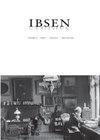Preface
IF 0.1
0 THEATER
引用次数: 0
Abstract
This decade’s first issue of Ibsen Studies dives into what Franco Moretti named the “core” of literary Europe, with three articles exploring conjunctions and interconnections between Ibsen and influential currents in Germany, France, and Britain—both before and after Ibsen’s lifetime. In “The Struggle for Existence: Ibsen’s The Wild Duck (1884),” Lisbeth Pettersen Wærp reads The Wild Duck in light of Darwin’s notions of domesticated diversity. Wærp broadens the metaphorical resonance of the loft by exploring its many constituents, that is all the animals, as well as books, furniture, and other objects. Contrary to much existing Ibsen scholarship, she argues that Ibsen does not equate domestication with degeneration. Rather, she sees the loft as “a value-neutral image of existential struggle under differing prevailing conditions” that, in turn, reflects the Ekdal and Werle families in the play. In other words, the article asks us to envision how the characters are embedded in a complex psychosocial force field. Martin Wåhlberg takes on a less frequently explored topic in “Diderot, Ibsen, and the Drame lyrique in Scandinavia.” The article expands upon previous work by Erik Østerud and Toril Moi, and traces how French writer and philosopher Denis Diderot (1713–1784) anticipates key elements of Ibsen’s drama. As Robert Weimann asserts regarding the practice of intertextuality, texts feed off each other in multiple ways. Wåhlberg does not argue that the relation and relevance of Diderot to Ibsen is a matter of direct influence; still, striking similarities emerge from Wåhlberg’s comparative analysis. He points out the mix between tragedy and comedy, prose plays, contemporary topics, domestic settings, and retrospective techniques, to name a few. Wåhlberg identifies Ibsen as Diderot’s heir, the “genius to realize the full potential of his dramatic reform.” The article thus contributes to an understanding of how French literature both circulated in前言
这十年来的第一期《易卜生研究》深入研究了佛朗哥·莫雷蒂所称的欧洲文学的“核心”,其中三篇文章探讨了易卜生与德国、法国和英国的影响潮流之间的联系和相互联系——无论是在易卜生生前还是死后。在《生存的斗争:易卜生的野鸭》(1884)中,莉斯贝丝·佩特森(Lisbeth Pettersen w . rp)根据达尔文驯化多样性的概念来解读《野鸭》。Wærp通过探索阁楼的许多组成部分,即所有的动物、书籍、家具和其他物品,拓宽了阁楼的隐喻共鸣。与许多现有的易卜生学术相反,她认为易卜生并没有把驯化等同于退化。相反,她认为阁楼是“在不同的普遍条件下存在斗争的价值中立的形象”,而这反过来又反映了剧中的埃克达尔和维尔家族。换句话说,这篇文章要求我们设想角色是如何嵌入复杂的社会心理力场的。马丁·瓦格尔伯格在《狄德罗、易卜生和斯堪的纳维亚的戏剧抒情》一书中探讨了一个不太常被探讨的话题。本文扩展了Erik Østerud和Toril Moi之前的工作,并追溯了法国作家和哲学家Denis Diderot(1713-1784)如何预测易卜生戏剧的关键元素。正如罗伯特·魏曼(Robert Weimann)关于互文性的实践所断言的那样,文本以多种方式相互依存。瓦尔伯格并不认为狄德罗与易卜生的关系和相关性是一个直接影响的问题;尽管如此,wamathlberg的比较分析还是出现了惊人的相似之处。他指出了悲剧与喜剧、散文剧、当代主题、家庭背景和回顾技巧的结合,等等。瓦格尔伯格认为易卜生是狄德罗的继承人,是“实现了他戏剧性改革的全部潜力的天才”。因此,本文有助于理解法国文学是如何在中国流传的
本文章由计算机程序翻译,如有差异,请以英文原文为准。
求助全文
约1分钟内获得全文
求助全文

 求助内容:
求助内容: 应助结果提醒方式:
应助结果提醒方式:


